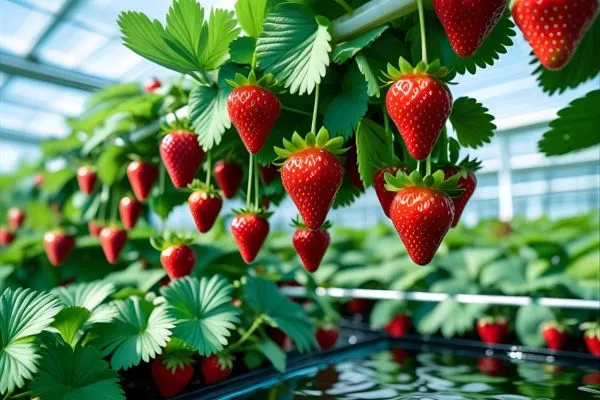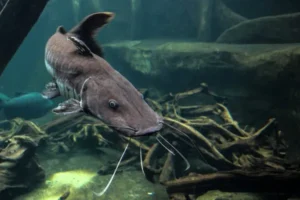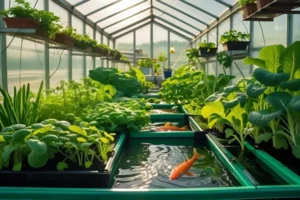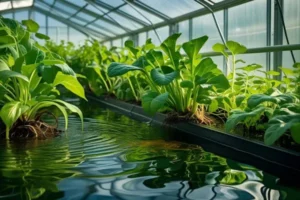Picture this: sweet, juicy strawberries growing year-round in your backyard, using 90% less water than traditional farming while producing fish as a bonus protein source. This isn’t a gardener’s fantasy—it’s the reality of aquaponics strawberries. As one of America’s most beloved fruits, with the average person consuming over 8 pounds annually, strawberries represent a $2.2 billion market that’s increasingly moving toward sustainable production methods.
Traditional strawberry farming faces mounting challenges: soil depletion, pesticide concerns, water scarcity, and unpredictable weather patterns that can devastate entire crops. Commercial strawberry farms typically require intensive chemical inputs, fumigation treatments, and massive water consumption—up to 12 gallons per pound of fruit produced. Home gardeners struggle with soil-borne diseases, pest management, and the heartbreak of watching their plants succumb to root rot or crown disease.
Growing strawberries in aquaponics systems offers a revolutionary solution that eliminates these traditional pain points while delivering superior results. This complete guide will walk you through everything you need to know—from selecting the perfect strawberry varieties for aquaponic systems to optimizing water parameters, choosing compatible fish species, and troubleshooting common challenges. Whether you’re a beginner exploring aquaponic strawberry production or an experienced grower looking to diversify your system, you’ll discover proven strategies for sweet success.
Why Choose Aquaponics for Growing Strawberries
Strawberry aquaponic systems deliver remarkable advantages that make them superior to traditional soil-based cultivation and even hydroponic methods. The symbiotic relationship between fish and plants creates an ideal environment for strawberry production that addresses the crop’s specific needs while maximizing yields and quality.
Superior Root Health and Disease Prevention: Strawberries are notoriously susceptible to soil-borne pathogens like Verticillium wilt, Phytophthora root rot, and nematodes. Aquaponics eliminates these threats entirely, as the sterile growing environment prevents soil-borne diseases while the constant water circulation provides optimal oxygenation to root systems. This results in healthier, more vigorous plants with dramatically reduced mortality rates—often under 5% compared to 15% to 20% in traditional farming.
Enhanced Nutrient Uptake: The dissolved nutrients from fish waste are readily available to strawberry plants in their ionic form, leading to faster absorption and more efficient nutrient utilization. Studies show aquaponics strawberry yields can exceed soil-grown counterparts by 30% to 50%, with fruit showing higher vitamin C content and superior flavor profiles due to optimal mineral balance.
Water Efficiency and Environmental Benefits: Traditional strawberry production requires approximately 12 gallons of water per pound of fruit, while aquaponic systems use only 1 to 2 gallons for the same yield through recirculation. This 85% to 90% water savings makes strawberry aquaponics particularly attractive in drought-prone regions like California, which produces 75% of America’s strawberries.
Economic Advantages: A properly managed strawberry aquaponic system generates dual income streams—premium organic strawberries commanding 8 to 12 USD per pound retail, plus fish harvests. Initial setup costs (2,000 to 5,000 USD for home systems) are typically recovered within 18 to 24 months through reduced grocery expenses and potential sales. Commercial operations report profit margins of 40% to 60% higher than conventional farming due to year-round production, premium pricing, and reduced input costs for pesticides and fertilizers.
Best Strawberry Varieties for Aquaponic Systems
Selecting the right aquaponic strawberry varieties is crucial for maximizing yields and ensuring system compatibility. Different strawberry types have varying nutrient requirements, growth patterns, and environmental preferences that directly impact aquaponic success.
Day-Neutral Varieties
Day-neutral strawberries are the gold standard for strawberry aquaponics due to their continuous production cycle. These varieties produce fruit regardless of daylight hours, making them ideal for controlled environment agriculture. ‘Albion’ stands out as the top performer, producing large, firm berries with excellent flavor and disease resistance. ‘San Andreas’ offers exceptional yields of 1.5 to 2.0 pounds per plant annually in optimized aquaponic systems. ‘Monterey’ provides consistent production and adapts well to varying water temperatures between 65°F to 75°F.
Everbearing Strawberries
Everbearing varieties produce two to three distinct harvest seasons, making them excellent for aquaponic systems with seasonal fish management. ‘Quinault’ produces extra-large berries weighing 0.5 to 0.8 ounces each and thrives in pH ranges of 6.0 to 6.5. ‘Ozark Beauty’ demonstrates remarkable adaptability to aquaponic conditions and produces runners that can be easily propagated within the system.
June-Bearing Considerations
While June-bearing varieties produce the largest single harvests (2.0 to 3.0 pounds per plant), their concentrated production period can strain aquaponic systems. ‘Honeoye’ and ‘Earliglow’ work best in larger commercial operations where the nutrient spike can be managed through increased fish feeding and system monitoring.
Recommended Cultivars by Climate
For northern climates (USDA zones 3 to 6): ‘Cavendish’, ‘Kent’, and ‘AC Valley Sunset’ tolerate temperature fluctuations and perform well in greenhouse aquaponics.
For southern regions (zones 7 to 10): ‘Florida Radiance’, ‘Sweet Charlie’, and ‘Chandler’ excel in warmer conditions and higher humidity environments.
For year-round indoor systems: ‘Seascape’ and ‘Portola’ offer compact growth habits perfect for vertical NFT systems and maintain consistent production under artificial lighting at 14 to 16 hours daily.
Setting Up Your Strawberry Aquaponics System
System Design Considerations
Strawberry aquaponic system setup requires careful planning to accommodate the crop’s unique growth patterns and root structure. Strawberries develop extensive root systems requiring 6 to 8 inches of growing depth and benefit from slight water circulation to prevent stagnation. Design your system with easy access for harvesting, as productive plants can yield fruit for 12 to 18 months before replacement.
Media Bed vs. NFT vs. DWC for Strawberries
Media bed systems provide optimal support for strawberry plants and excel at biological filtration. Use expanded clay pebbles or gravel sized 0.5 to 0.75 inches for proper drainage and root aeration. Beds should maintain 4 to 6 inches of media depth with flood and drain cycles every 15 to 20 minutes.
NFT (Nutrient Film Technique) works excellently for strawberry production, allowing easy harvesting access and efficient nutrient delivery. Design channels 4 to 6 inches wide with a gentle 1:30 to 1:40 slope. Flow rates of 0.5 to 1.0 gallons per minute per channel ensure adequate nutrition without root damage.
DWC (Deep Water Culture) suits strawberries when using floating rafts with 6-inch net pots. Maintain water levels 1 to 2 inches below the net pot bottom and ensure dissolved oxygen levels above 6 ppm through vigorous aeration.
Tank Size and Fish Stocking Ratios
For optimal strawberry aquaponics, maintain a 1:1 ratio between fish tank and growing bed volumes. A 100-gallon fish tank supports 20 to 25 strawberry plants effectively. Stock 1 pound of fish per 5 to 7 gallons of water, with tilapia being ideal due to their waste production matching strawberry nutrient requirements.
Planting Techniques and Spacing
Space strawberry plants 12 to 15 inches apart to prevent overcrowding and ensure adequate light penetration. Plant crowns level with the growing medium surface—too deep causes crown rot, while too shallow exposes roots. Remove runners initially to encourage fruit production, then allow 2 to 3 runners per plant for system propagation after the first harvest season.
Water Parameters and Nutrient Management
Optimal pH Levels for Strawberries
Strawberry aquaponics water parameters require precise management for maximum productivity. Maintain pH between 6.0 to 6.5 for optimal nutrient uptake—this slightly acidic range allows strawberries to efficiently absorb iron, phosphorus, and micronutrients while keeping fish healthy. Monitor pH twice daily during establishment, then weekly once stabilized. Use potassium hydroxide to raise pH or phosphoric acid to lower it, adding small amounts (0.1 pH increments) to prevent shocking the system.
Nutrient Requirements (NPK Ratios)
Strawberries thrive with NPK ratios of 10-5-10 during vegetative growth, shifting to 5-10-10 during flowering and fruiting. Fish waste typically provides adequate nitrogen (10 to 15 ppm), but phosphorus may require supplementation to reach optimal levels of 30 to 50 ppm. Potassium demands are high during fruit development—maintain 150 to 200 ppm through organic potassium supplements or carefully monitored potassium sulfate additions.
Critical Micronutrients: Iron deficiency appears quickly in strawberries, causing chlorosis in new growth. Maintain iron levels at 2 to 3 ppm using chelated iron supplements. Calcium requirements (60 to 80 ppm) support strong cell walls and prevent fruit disorders. Magnesium (25 to 30 ppm) ensures proper chlorophyll function and fruit quality.
Water Temperature Management
Maintain water temperatures between 65°F to 75°F (18°C to 24°C) for optimal strawberry performance. Temperatures above 80°F (27°C) reduce fruit set and quality, while below 60°F (15°C) slows growth significantly. Use aquarium heaters for cold climates or chilling systems in hot regions to maintain stability.
Monitoring and Testing Protocols
Test ammonia and nitrite weekly—levels above 0.5 ppm indicate biological filter stress. Nitrate should remain between 20 to 40 ppm for optimal strawberry nutrition. Monitor dissolved oxygen levels, maintaining above 6 ppm through adequate aeration. Weekly electrical conductivity (EC) testing ensures total dissolved solids remain between 800 to 1,200 μS/cm. Document all parameters in a logbook to identify trends and optimize system performance over time.
Fish Selection for Strawberry Aquaponics
Compatible Fish Species for Strawberries
Selecting the right fish for strawberry aquaponics ensures optimal nutrient production while maintaining system balance. Tilapia remains the gold standard, producing waste rich in nitrogen and phosphorus that perfectly matches strawberry nutritional needs. Their tolerance for pH fluctuations (6.0 to 8.0) aligns well with strawberry requirements, and they reach market size (1.0 to 1.5 pounds) in 6 to 9 months.
Trout excel in cooler climates, thriving in water temperatures of 55°F to 68°F (13°C to 20°C). Rainbow trout produce high-quality waste for strawberry nutrition and command premium market prices of 8 to 12 USD per pound. Their faster metabolism generates more nutrients per pound of fish, supporting higher strawberry plant densities.
Catfish offer excellent disease resistance and adaptability to varying water conditions. Channel catfish grow steadily in temperatures from 65°F to 85°F (18°C to 29°C) and produce consistent waste output. Their market value ranges from 4 to 6 USD per pound, making them economically viable for commercial operations.
Temperature Requirements Alignment
Aquaponics fish strawberry combinations must share compatible temperature ranges. The optimal overlap occurs at 68°F to 72°F (20°C to 22°C), where both strawberries and most fish species perform well. This temperature promotes active fish feeding, consistent waste production, and peak strawberry flowering.
Feeding Schedules and Waste Production
Feed fish 2% to 3% of their body weight daily, divided into 2 to 3 meals for optimal digestion and waste production. A 100-pound fish load produces sufficient nutrients for 20 to 25 strawberry plants when fed high-quality pellets with 32% to 35% protein content.
Market Value Considerations
Dual-purpose systems maximize profitability through strategic fish selection. Premium species like Arctic char (12 to 15 USD per pound) or hybrid striped bass (7 to 10 USD per pound) significantly boost revenue streams. Calculate feed conversion ratios (1.2:1 to 1.8:1 for quality fish) against market prices to optimize system economics and ensure sustainable strawberry production alongside profitable fish harvests.
Common Challenges and Solutions
Disease Management in Aquaponics
Strawberry aquaponics problems often stem from fungal diseases thriving in high-humidity environments. Gray mold (Botrytis cinerea) appears as fuzzy gray growth on fruits and leaves, particularly when humidity exceeds 85%. Combat this by maintaining air circulation with fans running 12 to 16 hours daily and spacing plants adequately for airflow. Powdery mildew manifests as white, powdery spots on leaves when temperatures fluctuate between 60°F to 80°F (15°C to 27°C). Prevent outbreaks by maintaining consistent temperatures and applying organic neem oil solutions at 0.5% to 1.0% concentration weekly.
Nutrient Deficiency Symptoms
Iron deficiency creates the most common aquaponics strawberry issues, causing yellowing between leaf veins while veins remain green. This occurs when pH rises above 7.0, making iron unavailable. Correct by lowering pH to 6.0 to 6.5 and adding chelated iron at 2 to 3 ppm concentrations.
Phosphorus deficiency appears as purple or red discoloration on older leaves, often coinciding with poor fruit development. Increase fish feeding by 10% to 15% or supplement with organic phosphorus sources, targeting 30 to 50 ppm levels.
Root Rot Prevention
Root rot develops when water circulation slows or stops, creating anaerobic conditions. Symptoms include black, mushy roots and wilting despite adequate water. Prevent by ensuring continuous water flow (0.5 to 1.0 gallons per minute in NFT systems) and maintaining dissolved oxygen above 6 ppm through vigorous aeration.
Pest Control Strategies
Aphids and spider mites pose primary threats in enclosed strawberry aquaponic systems. Deploy beneficial insects like ladybugs (500 to 1,000 per 100 plants) and predatory mites for biological control. Sticky yellow traps capture flying pests effectively—place 1 trap per 4 to 6 plants. For severe infestations, apply organic insecticidal soap at 2% to 3% concentration, ensuring fish safety by treating during low-feeding periods and monitoring water parameters closely for 24 to 48 hours post-application.
Harvesting and Yield Expectations
Optimal Harvest Timing for Strawberries
Aquaponics strawberry harvest timing directly impacts fruit quality and plant productivity. Harvest berries when 75% to 80% of the surface shows full red coloration—this ensures optimal sugar content (8 to 12 Brix) and maximum shelf life of 5 to 7 days. Pick fruits every 2 to 3 days during peak season to prevent overripening and encourage continued production. Early morning harvesting (6:00 AM to 9:00 AM) yields firmer fruits with better storage characteristics due to cooler temperatures and higher moisture content.
Expected Yields Per Plant and Per System
Well-managed strawberry aquaponic systems produce exceptional yields compared to traditional farming. Day-neutral varieties like ‘Albion’ and ‘San Andreas’ yield 1.5 to 2.5 pounds per plant annually under optimal conditions. Everbearing varieties produce 1.0 to 1.8 pounds per plant with concentrated harvest periods.
A 100-square-foot aquaponic system supporting 25 plants typically generates 40 to 60 pounds of strawberries annually. Commercial operations achieve 3.0 to 4.5 pounds per square foot yearly—significantly exceeding field production of 1.2 to 2.0 pounds per square foot. Peak production occurs 60 to 90 days after planting, with consistent harvests continuing for 8 to 12 months before plant replacement.
Quality Indicators and Grading
Premium aquaponic strawberries exhibit uniform red coloration, firm texture, and strong aromatic fragrance. Grade berries by size: Extra Large (>1.5 inches diameter), Large (1.0 to 1.5 inches), and Medium (0.75 to 1.0 inches). Aquaponic fruits typically show 20% to 30% larger average size than soil-grown counterparts due to optimal nutrition.
Succession Planting Strategies
Implement succession planting every 4 to 6 weeks to ensure continuous harvests. Replace 20% to 25% of plants quarterly, maintaining system productivity while preventing age-related decline. This strategy extends harvest seasons by 3 to 4 months annually and maintains peak yields throughout the growing cycle. Propagate runners from high-producing mother plants to maintain genetic consistency and superior performance characteristics across successive plantings.
Conclusion
Strawberry aquaponics represents a revolutionary approach to sustainable food production that delivers exceptional results for both novice and experienced growers. Throughout this comprehensive guide, we’ve explored how aquaponic systems eliminate soil-borne diseases, reduce water consumption by 85% to 90%, and generate yields 30% to 50% higher than traditional farming methods.
The key to success lies in selecting appropriate day-neutral varieties like ‘Albion’ and ‘San Andreas’, maintaining optimal water parameters (pH 6.0 to 6.5, temperatures 65°F to 75°F), and choosing compatible fish species that provide consistent nutrient production. With proper system design—whether NFT, media beds, or DWC—your aquaponic strawberry system can produce 1.5 to 2.5 pounds per plant annually while generating dual revenue streams from both fruit and fish harvests.
The economic advantages are compelling: initial investments of 2,000 to 5,000 USD typically recover costs within 18 to 24 months, while commercial operations report profit margins 40% to 60% higher than conventional farming. More importantly, aquaponics offers food security, environmental sustainability, and the satisfaction of producing premium, pesticide-free strawberries year-round.
As water scarcity and environmental concerns intensify globally, strawberry aquaponics positions you at the forefront of agricultural innovation. The technology is proven, the benefits are substantial, and the time to start is now.
Ready to transform your growing potential? Share your aquaponics journey plans in the comments below, and don’t forget to download our free “Strawberry Aquaponics Startup Checklist” to ensure your system launches successfully from day one!
Frequently Asked Questions (FAQ)
How long does it take to harvest strawberries in an aquaponic system?
Aquaponic strawberries typically produce their first harvest 60 to 90 days after planting, depending on the variety and growing conditions. Day-neutral varieties like ‘Albion’ begin fruiting continuously once established, while everbearing types produce 2 to 3 distinct harvest periods annually. Peak production occurs 3 to 4 months after system establishment.
How many strawberries does one plant produce in aquaponics?
A healthy strawberry aquaponics plant yields 1.5 to 2.5 pounds annually, equivalent to 150 to 300 individual berries depending on size. Day-neutral varieties produce consistently for 8 to 12 months, while everbearing plants concentrate production into specific seasons. Aquaponic yields typically exceed soil-grown plants by 30% to 50%.
What’s the minimum space needed for a strawberry aquaponics system?
A beginner home aquaponics strawberry system requires just 20 to 30 square feet of space. This accommodates a 40 to 55-gallon fish tank and growing beds for 8 to 12 plants. Vertical NFT systems can support 15 to 20 plants in just 15 square feet of floor space, making aquaponics suitable even for apartments and balconies.
Do aquaponic strawberries taste different from soil-grown ones?
Aquaponic strawberries often taste superior to conventional berries due to optimal nutrient availability and consistent growing conditions. The controlled environment produces fruits with 15% to 20% higher sugar content (Brix levels) and more intense flavor profiles. Many growers report that aquaponic berries have firmer texture and longer shelf life.
What’s the initial cost to start a strawberry aquaponics system?
Home strawberry aquaponic systems cost 500 to 1,500 USD for basic setups supporting 10 to 15 plants. Mid-size systems (2,000 to 5,000 USD) accommodate 25 to 50 plants and include automation features. Commercial operations require 8,000 to 15,000 USD per 100-plant system, but typically recover investments within 18 to 24 months through dual harvests.
Can beginners successfully grow strawberries in aquaponics?
Absolutely! Strawberry aquaponics is beginner-friendly when following proven guidelines. Start with hardy day-neutral varieties and maintain basic water parameters (pH 6.0 to 6.5, temperature 65°F to 75°F). Weekly monitoring and simple maintenance routines ensure success. Many beginners achieve excellent results within their first growing season.
How do I control pests organically in strawberry aquaponics?
Organic pest control in aquaponics relies on beneficial insects, sticky traps, and fish-safe treatments. Deploy ladybugs (500 to 1,000 per 100 plants) for aphid control and use yellow sticky traps for flying pests. Neem oil at 0.5% to 1.0% concentration effectively manages soft-bodied insects without harming fish when applied during low-feeding periods.
Which fish work best with strawberry aquaponics?
Tilapia excel as fish for strawberry aquaponics due to their waste production matching strawberry nutrient needs and pH tolerance (6.0 to 8.0). Trout work well in cooler climates (55°F to 68°F), while catfish offer disease resistance and adaptability. Stock 1 pound of fish per 5 to 7 gallons for optimal nutrient production supporting strawberry growth.



